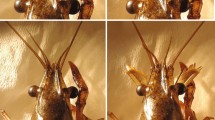Summary
-
1.
In response to abrupt mechanical stimuli delivered to the rostrum or telson, the Norway lobster, Nephrops norvegicus, performs short-latency tail flips (Fig. 2) which are preceded by giant fibre activity in the abdominal nerve cord (Fig. 1).
-
2.
High speed cinematography of freely moving animals demonstrates that two distinct categories of giant fibre mediated tail flip are elicited by stimuli to the rostrum or telson (Fig. 3), and that these have flat or elevated rearward trajectories, respectively (Fig. 4). By analogy with the crayfish these have been identified as MG and LG flips. A third, more variable form of swimming tail flip follows these initial giant fibre flips.
-
3.
Analysis of tail flip flexion in terms of the velocities of abdominal segments relative to the centre of mass (Fig. 5) and of intersegmental angles (Fig. 6) reveals gradients in the order of flexion according to the site of stimulation: caudo-rostrally for the MG flip and rostrocaudally for the LG flip.
-
4.
The timings of flexion movements have been studied in tethered animals using a combination of movement monitors, a force transducer, and electromyographical recordings (Figs. 7–10). These confirm that differences exist in both the form of abdominal flexion and the order of activation of the segments in MG and LG flips (Figs. 7, 8). They also demonstrate that, in contrast to the crayfish, all segments flex during the LG flip (Fig. 9). These features are also expressed when the tail flip is induced by direct electrical stimulation of the giant fibres (Fig. 10).
-
5.
The differences observed between Nephrops and crayfish in the tail flip trajectories and the contribution of caudal flexion to the LG flip are discussed in terms of the underlying neuronal circuitry.
Similar content being viewed by others
Abbreviations
- CDI :
-
corollary discharge interneuron
- COM :
-
centre of mass
- FF :
-
fast flexor motoneuron
- f.p.s. :
-
frames per second
- GF :
-
giant fibre
- LG :
-
lateral giant
- MG :
-
medial giant interneuron
- MoG :
-
motor giant
- SG :
-
segmental giant neuron
References
Ache BW, Macmillan DL (1980) Neurobiology. In: Cobb JS, Phillips BF (eds) The biology and management of lobsters. I. Physiology and behaviour. Academic Press, New York, pp 165–213
Cattaert D, Clarac F, Neil DM (1988) Anatomical and physiological organisation of the swimmeret system of the spiny lobster Jasus lalandii as adaptive components of the tail flip. J Comp Physiol A 162:187–200
Cooke IRC, Macmillan DL (1985) Further studies of crayfish escape behaviour. I. The role of the appendages and the stereotyped nature of non-giant escape swimming. J Exp Biol 118:351–365
Dumont JPC, Robertson RM (1986) Neuronal circuits: an evolutionary perspective. Science 233:849–853
Dumont JPC, Wine JJ (1987a) The telson flexor neuromuscular system of the crayfish. I. Homology with the fast flexor system. J Exp Biol 127:249–278
Dumont JPC, Wine JJ (1987b) The telson flexor neuromuscular system of the crayfish. II. Segment-specific differences in connectivity between premotor neurones and the motor giant. J Exp Biol 127:279–294
Dumont JPC, Wine JJ (1987c) The telson flexor neuromuscular system of the crayfish. III. The role of feedforward inhibition in shaping a stereotyped behaviour pattern. J Exp Biol 127:295–311
Govind CK, Lang F (1976) Growth of lobster giant axons: correlation between conduction velocity and axon diameter. J Comp Neurol 170:421–434
Kramer AP, Krasne FB, Wine JJ (1981) Interneurons between giant axons and motoneurons in crayfish escape circuitry. J Neurophysiol 45:550–573
Krasne FB, Wine JJ (1988) Evasion responses of the crayfish. In: Guthrie DM (ed) Aims and methods in neuroethology. Manchester University Press, Manchester, pp 10–45
Lang F, Govind CK, Costello WJ, Greene SI (1977) Developmental neuroethology: changes in escape and defensive behavior during growth of the lobster. Science 197:682–685
Larimer JL, Eggleston AC, Masukawa LM, Kennedy D (1971) The different connections and motor outputs of lateral and medial giant fibres in the crayfish. J Exp Biol 54:391–402
Main J, Sangster GI (1985) The behaviour of the Norway lobster, Nephrops norvegicus (L.) during trawling. Scottish Fisheries Research Report 34
Miller LA, Hagiwara G, Wine JJ (1985) Segmental differences in pathways between crayfish giant axons and fast flexor motoneurons. J Neurophysiol 53:253–265
Mittenthal JE, Wine JJ (1973) Connectivity of crayfish giant interneurons:visualisation of synaptic regions with cobalt dye. Science 179:182–184
Newland PL (1985) The control of escape behaviour in the Norway lobster, Nephrops norvegicus. Ph.D. Thesis, University of Glasgow
Newland PL, Chapman CJ (1989) The swimming and orientation behaviour of the Norway lobster, Nephrops norvegicus (L.) in relation to trawling. Fish Res 8:63–80
Newland PL, Neil DM (1990) The tail flip of the Norway lobster, Nephrops norvegicus. II. Dynamic righting reactions induced by body tilt. J Comp Physiol A 166:529–536
Newland PL, Chapman CJ, Neil DM (1988) Swimming performance and endurance in the Norway lobster, Nephrops norvegicus. Mar Biol 98:345–350
Otsuka M, Kravitz EA, Potter DD (1967) Physiological and chemical architecture of a lobster ganglion with particular reference to GABA and glutamate. J Neurophysiol 30:725–752
Reichert H, Wine JJ (1983) Co-ordination of lateral giant and non-giant systems in crayfish escape behavior. J Comp Physiol 153:3–15
Roberts AM, Krasne FB, Hagiwara G, Wine JJ, Kramer AP (1982) Segmental giant: evidence for a driver neuron interposed between command and motor neurones in the crayfish escape system. J Neurophysiol 47:761–781
Shelton PMJ, Gaten E, Chapman CJ (1985) Light and retinal damage in Nephrops norvegicus (L.) (Crustacea). Proc R Soc Lond B 226:217–263
Sillar KT, Heitier WJ (1985) The neural basis of escape swimming behaviour in the squat lobster Galathea strigosa. J Exp Biol 117:251–269
Takahata M, Wine JJ (1987) Feedforward afferent excitation of peripheral inhibitors in the crayfish escape system. J Neurophysiol 58:1452–1467
Uyama C, Matsuyama T (1980) Coordinated excitation of flexor inhibitors in the crayfish. J Exp Biol 86:187–195
Webb PW (1979) Mechanics of escape responses in crayfish (Orconectes virilis). J Exp Biol 79:245–263
Wiersma CAG (1947) Giant nerve fiber system of the crayfish. A contribution to the comparative physiology of synapse. J Neurophysiol 10:23–38
Wine JJ (1984) The structural basis of an innate behaviour pattern. J Exp Biol 112:283–319
Wine JJ, Krasne FB (1972) The organisation of escape behaviour in the crayfish. J Exp Biol 56:1–18
Wine JJ, Krasne FB (1982) The cellular organisation of crayfish escape behavior. In: Sandeman DC, Atwood HL (eds) The biology of Crustacea vol 4: Neural integration and behaviour. Academic Press, New York, pp 241–292
Wine JJ, Mistick DC (1977) Temporal organisation of crayfish escape behavior: delayed recruitment of peripheral inhibition. J Neurophysiol 40:905–925
Author information
Authors and Affiliations
Rights and permissions
About this article
Cite this article
Newland, P.L., Neil, D.M. The tail flip of the Norway lobster, Nephrops norvegicus . J Comp Physiol A 166, 517–527 (1990). https://doi.org/10.1007/BF00192022
Accepted:
Issue Date:
DOI: https://doi.org/10.1007/BF00192022




